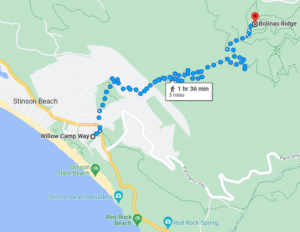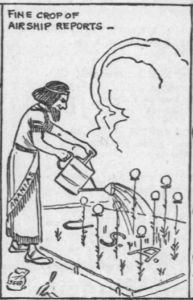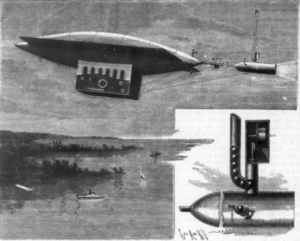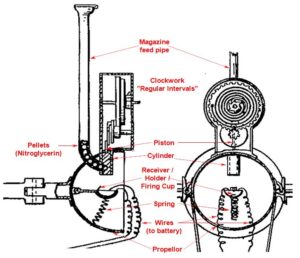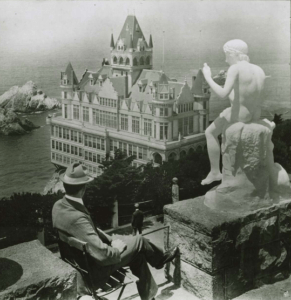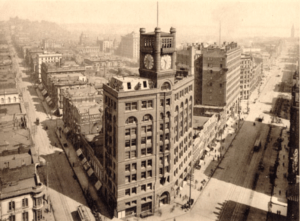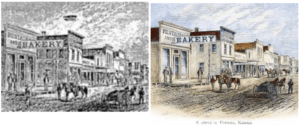Prompted by Karl Kluge, I’ve been reading Dennis Crenshaw’s “The Secrets of Dellschau” to try to work out my own angle on the mysterious Sonora Aero Club and its alleged airships. However, when Crenshaw mentions Mount Tamalpais (in connection with the 1896 Airship Flap in California), he refers to two articles from The San Francisco Call that I hadn’t previously quoted here. I’ve been relying on newspapers.com, and annoyingly it doesn’t always find the articles you want: the magic keyphrase that happened to unlock the door here was “Bolinas Ridge“.
Bolinas Ridge
Bolinas Ridge starts close to Mount Tamalpais, and has a picturesque trail that runs along it for several miles. For example, here’s an Oct 1896 story about “four ladies from the Hotel Rafael” riding along Bolinas Ridge being caught out by a sudden fog dropping, and having to spend the night in a makeshift campsite under the redwoods sitting on saddles. Other newspaper stories of Bolinas Ridge tell tales of encounters with “an enraged deer” or panther, or of forest fires, etc
More importantly (for airship historians), here’s the Call article from 19 Nov 1896 (p.1) mentioned by Crenshaw, and which was the final one of Daniel Cohen’s four early airship-flap mentions that I wasn’t previously able to dig up:
SEEN THREE WEEKS AGO.
Story Told by a Hunter Living on Bolinas Ridge
On Sunday, the first day of this month, a representative of THE CALL met on Bolinas Ridge, just to the west of Mount Tamalpais, an old hunter living there, named Brown. The old man was very nervous and started a conversation immediately by asking:
“Do I look like a crazy man?”
“Why certainly not, Mr. Brown. Why do you ask?”
“Well,” he replied, “I don’t expect anybody to believe me. To tell the truth I can hardly believe myself. But it’s an honest fact that yesterday morning, when the fog began to lift, I saw an airship right up there a couple of hundred feet over them pines.
“No, I can’t tell you much what she looked like. She didn’t show very plainly through the mist, but it was a large, dark shape with something moving on it. Don’t know whether I saw any people or not. It came on me so sudden I was almost stunned, and by the time I collected my senses she was out of sight.
“I have been kind of dazed ever since, and to have you tell me that I don’t look crazy is a great relief. But I know that what I saw was an airship.”
As the “superior” type of mirage is not uncommon to people living on the Marin hills it was thought that this was what the old man had seen, so no attention was paid to his story. The mirage effect of a large ocean vessel passing through the sky might appear to him like some new-fangled machine for navigating the air.
Perhaps the mirage is what he really saw, but in the face of the stories circulated in regard to the airship there is a probability that is what Mr. Brown really saw. Certainly he would have no object in telling such a story.
Thomas/William Jordan of San Rafael
The other Call article (23 Nov 1896, p.1) referred to a previous article I quoted here:
One of the most interesting of the corroborative stories comes from Thomas Jordan of San Rafael, who states that he found a machine-shop in a mountain fastness some months ago: that six men were working on an airship and that it would soon be completed.
In the first day’s story of the airship, as printed in THE CALL, it was stated that an old hunter named Brown of Bolinas Ridge had seen an airship floating a few hundred feet above the pine trees one morning just as the fogs were lifting from the ridge.
It seems that The Call’s journalist misremembered “William Jordan” as “Thomas Jordan” (as per the original article I quoted here).
“Strange Lights At Sea”
Incidentally, I did find one curious story in the San Francisco Examiner of 19 Jun 1894 (p.8) that might possibly have been related to the 1896 Airship Flap:
STRANGE LIGHTS AT SEA
Will-o’-the-Wisps That Deceive the Life-Saving Crews.
Flare Lights and Rockets Seen at Night Near Bolinas by the Watchers at the Point Lobos Observatory Station.
What are those strange lights at sea, those blue rockets and flare lights and flashes of yellow fire that are thrown at night from the water’s surface against the inky background of the hills that seem to crowd Bolinas into the sea?
Twice within a fortnight that have been seen by the lonely watchers at Point Lobos, and as many times they have been mistaken for signals of distress, whereupon tug boats have been sent out from the city, and these have towed one or more of the life-saving crews out to sea to search for mariners in distress.
Each time these errands have been fruitless, and not a trace could be found of the origin of the mysterious signals.
Two weeks ago last Sunday night the lights were first seen by the Golden Gate Life-Saving crew’s lookout on Point Lobos.
“I began to see the lights flashing about 9 o’clock in the evening,” he says, “and they continued for over two hours.” […]
“They were flare lights mostly, but I am certain there were some blue rockets fired from the same point during the evening. The lights were intermittent and a good deal like those that would be flashed from a ship in distress.
“Last night I saw the same lights again, almost in the same place, over there near Bolinas. Those hills are so black over there at night that I could see the flashes very plainly, though it was a cloudless and moonlight evening. About 9 o’clock they commenced. At times a great streak of yellow would be flashed up straight against the black hills, and I was sure they must be signals of distress from some craft or small boat in Bolinas Bay.”
[…] Some are inclined to think that the lights were signals to or from small crafts engaged in smuggling, but the most prevalent theory now is that picnickers at Willow Camp have been having bonfires and fireworks among their other sports.
Willow Camp Hotel
I’ve been trying to work out who the mysterious “Mr Brown” was. Though by 1896 Mount Tamalpais had started to become a popular summer destination for visitors, October/November would have been out of season. The report (in Cohen p.9) characterised Brown as a recluse, but was that the whole story?
One possibility is that could have been the John W. “Bill” Brown (born May 2, 1863) who owned the nearby Willow Camp Hotel on Stinson Beach in Bolinas Bay, at the foot of Mount Tamalpais. Despite its impressive-sounding name, this was simply a set of tents in the shade of the willow trees. Previously, Brown had shared the ownership with a Mr Jukes, but in 1894 he bought out the other man’s share to run the enterprise with his sister Dolly Brown and mother Lucinda. (He sold it to William Neumann in 1903-1904: Brown died in 1946 in Mill Valley.)
In this 1894 article, we can see more than a hundred people (including Miss Dolly Brown) staying at Willow Camp, and there’s a nice scenic description here (though don’t eat the mussels). From there it would have been a three-mile hike to Bolinas Ridge:
On the other hand, I have to point out that despite his proximity to the ridge, Bill Brown doesn’t sound at all like an “old hunter”: but I haven’t yet got an alternative candidate. I’ll keep looking.
